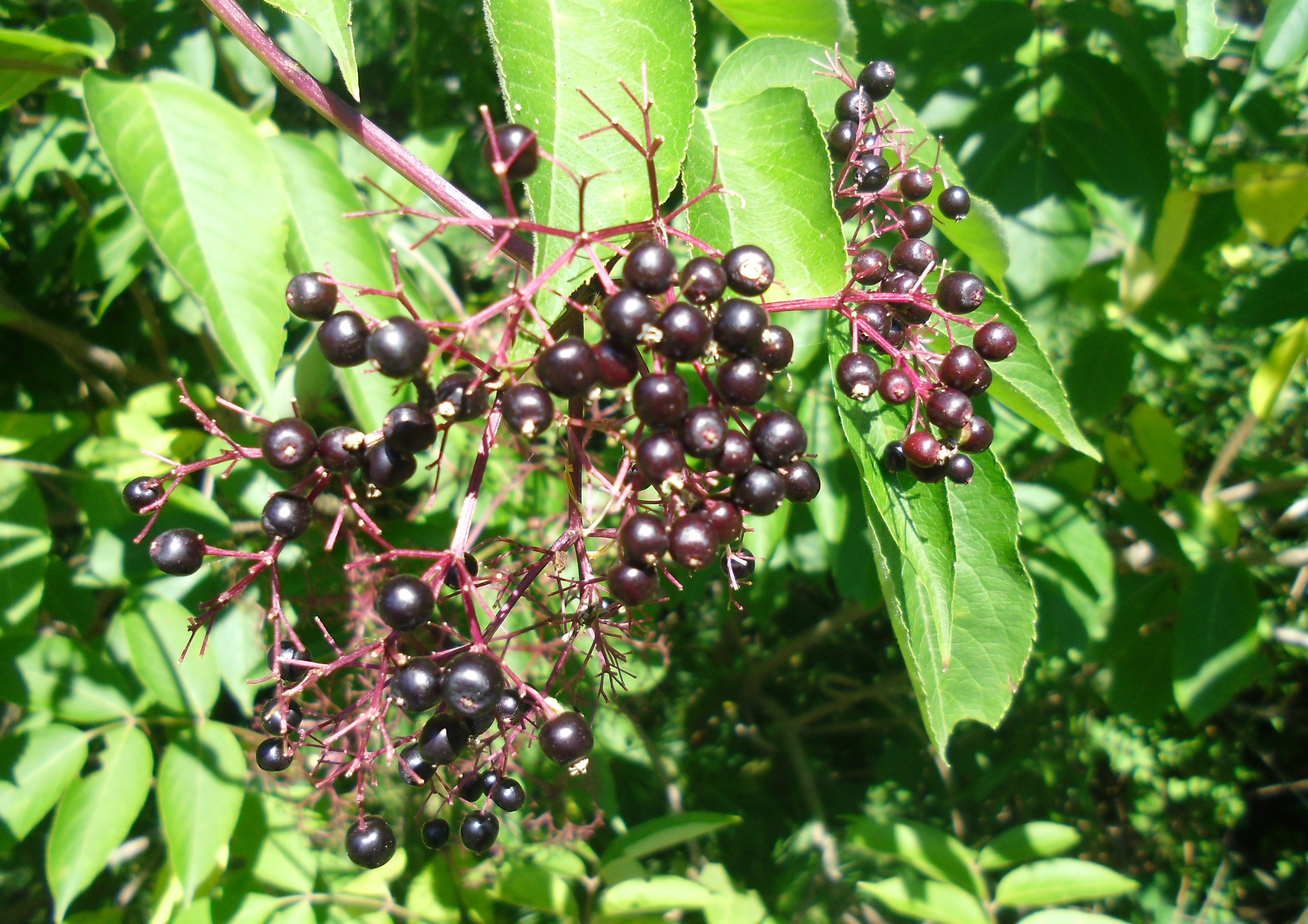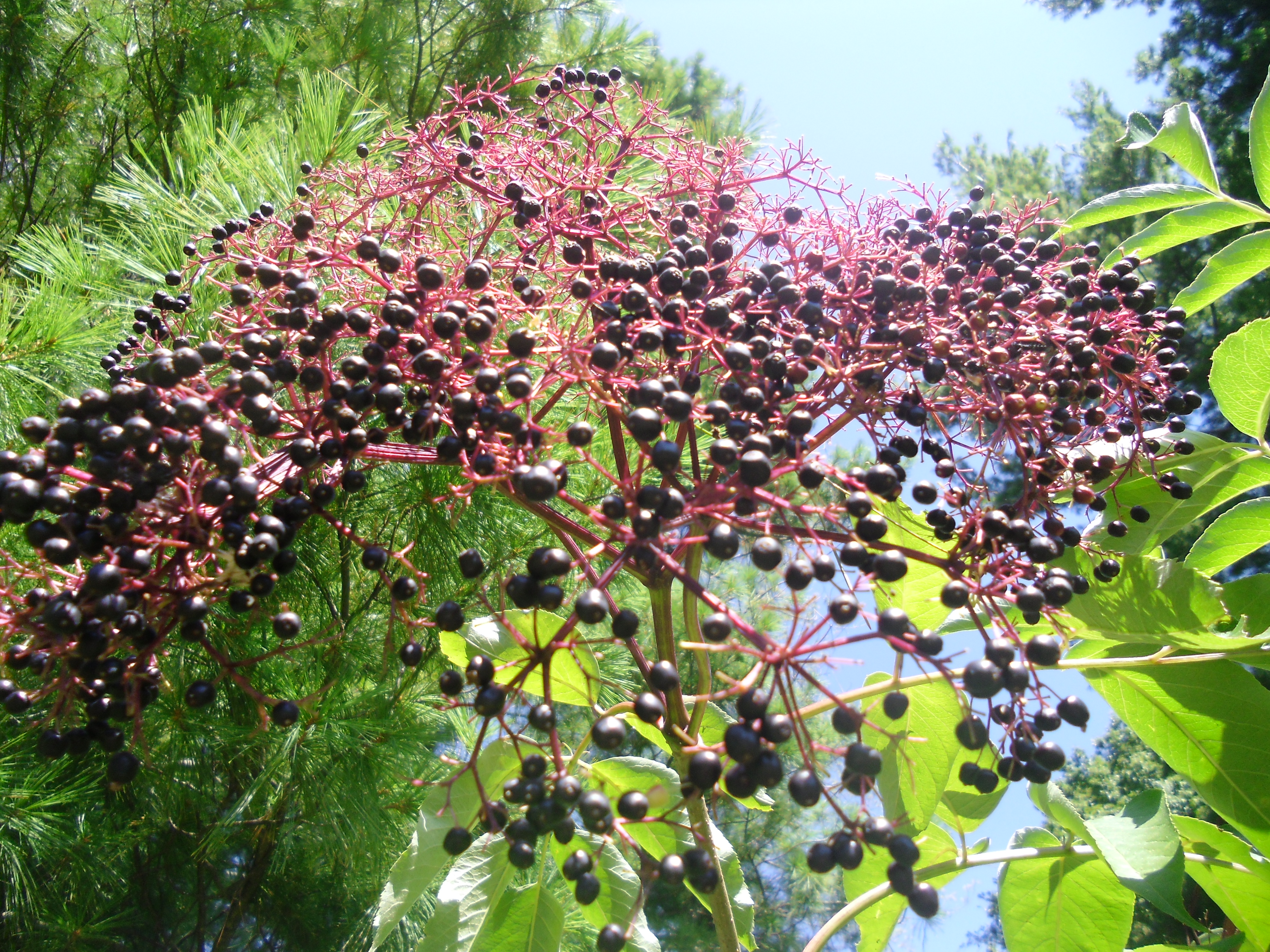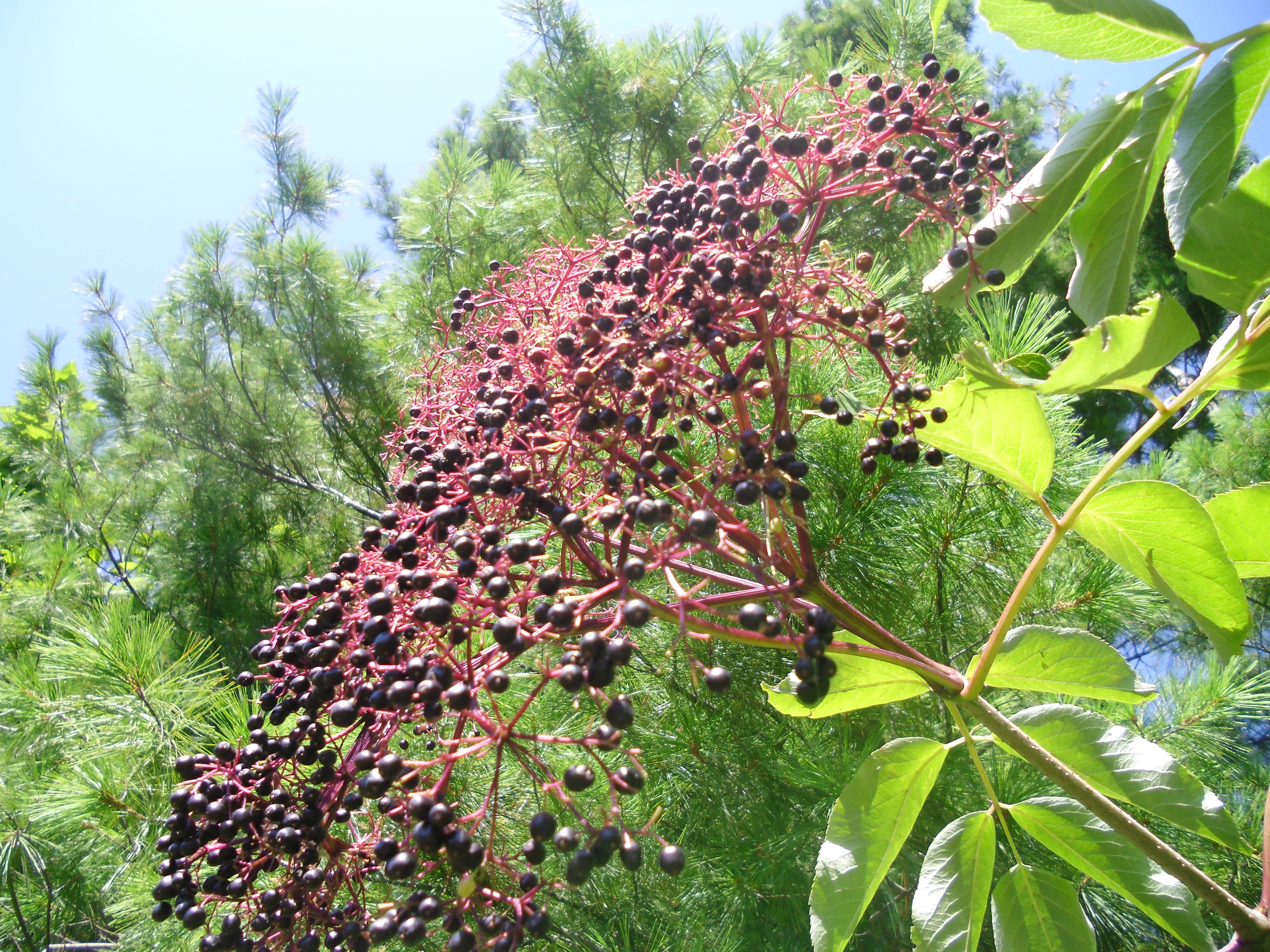Elderberries
Clusters of small white flowers dropping from the elder tree give signal to the nearby arrival of small, round, juicy, deep-purple elderberries. Hanging in clumps from the busy branches of the 5-12 foot elder tree (or shrub)- they’re not difficult to spot. The most well known species is the American elder. This medium to large shrub is a member of the honeysuckle family- and has smooth, gray bark and opposite, compound leaves. The leaves are divided into several sharply serrated, 2-5 inch elliptical (widest in the middle- and tapering evenly to both ends) leaflets. The fragrant, lacy blooms of the American elder open in late June and July and contain hundreds of five-petaled, white flowers that span out about 6 inches.
Like most wild plants, the berries of the elder bush are packed with highly bioavailable nutrients. They provide large amounts of potassium and beta-carotene as well as calcium, phosphorous and vitamin C.
The fun scoop: The most powerful wand (the ‘Elder Wand’) in the Wizarding World of Harry Potter is concocted of wood from Sambucus canadensis or the American elder. Because I am a fan of all things magical, especially in relation to the hidden (and not so hidden) mystical properties of the sacred plants around us- I’m further pushed to share that in European folklore, fairies and elves would appear if you sat underneath an elder bush during midsummer nights. Interesting, as the strong scent of large masses of elder leaves are thought by some to have a mild narcotic effect. It is written that the lovely elder possessed potent magic~ with the capability of driving away evil-doers. Pocketing the twigs was considered a charm against certain illnesses. All passed down tales aside, my guess is that much of the elder’s charm hails from its ability to heal. The flowers and fruit are wonderfully medicinal. Hippocrates had already made note of this in 400 B.C……..
Elderberries have diuretic and detoxifying properties~ and elder flower water is infamous for its skin softening and restorative actions. Bioflavinoids support circulation and capillaries. An infusion or tincture is commonly used to help alleviate ‘colds’ and ‘flu’ as it is astringent, expectorant and induces perspiration- making it helpful for bringing down a fever. The flowers can be steeped in oil to make a soothing ointment for sore muscles, burns and rashes.
The berries and the flowers of the elder bush are edible. The leaves, roots and bark (though medicinally mentioned in several older herbal books) contain a bitter alkaloid and glycoside that may change into cyanide~ and are not edible!
Harvesting elderberries is fairly easy- a carrier bag or bucket and a good pair of scissors (or simply your hands to pinch off clusters) will reward you with a bag full of berries in very little time. Each berry can, then, be removed from their stems~ however, if you do not want to take the time for this semi-tedious task or to deal with berry stained hands~ the following method will be a treasure;). -> Simply place the entire clusters in the freezer- giving space to each on a plate or tray of some sort. After the berries have frozen solid, they are very easily removed by rubbing the clusters of berries between your hands. Make sure to do this over a large bowl as the berries snap off from the stems easily and can become a bit of a nightmare to cleanup if not careful. You can place the frozen berries back into the freezer for later use or use them frozen or thawed in recipes.
I have read that elderberries (like the above mentioned leaves, roots and bark) also contain a certain amount of cyanide. While eating a few of them raw doesn’t necessarily create a problem (noshing on a couple is so much fun while collecting)- eating too many can make for a not-so-pleasant experience. Cooking the berries apparently takes the cyanide out, making them safe for consumption. I’ve experienced my fair share of feeling ill after ‘testing’ out non-staple food items…and, as a result, have not been brave enough to test the limits of raw berry consumption;). With foraging, I like to lean towards safety and familiarity, at any rate, and would suggest cooking the berries if you’re planning to eat many of them.
Elderberry syrup is a staple in many of my herbalist friends’ cabinets—after perusing through several past shared recipes, however, I have opted not to dabble in syrup making almost solely based on the amount of sugar that it takes to preserve the concoction. It’s true- I have a ‘thang’ against concentrated sugar, and am dedicated to avoiding sizeable amounts of it. That written, I’m not as enthusiastic about side stepping the antioxidant bliss of elderberries altogether- so, after much ‘strategery’ (thank you, G. W. Bush;)), I decided to try freezing the cooked elderberry juice~ a method that I’ve successfully used for preserving other juices and herbs…it worked out quite well………
Elderberry Juice Cubes
- Pick berries off stems as best you can (you can use a fork to separate berries from stems, or use the freezer method described above.)
- Rinse berries in a bowl of cold water until clear and clean~ drain water.
- Using a size appropriate pot, heat on medium-low heat for 20-30 minutes~ stirring frequently (berries will turn from a black-purpl’ish color to red-purpl’ish once they’re all cooked.)
- Remove from burner, let them cool off a bit~ then mash them up using a potato masher or the bottom end of a glass jar. Try to release as much juice from the berries as possible.
- Spoon (or pour) mixture into a strainer positioned over a bowl, and press with a spoon to push the juice through.
- Pour syrup into ice cube trays and freeze. When you need an immune system boost, just pop a couple out and blend with leafy greens, fruit, spring water, lemon juice (whatever sounds good) for a rejuvenating treat!
*blending nutrient~dense leafy greens with antioxidant and water~rich fruits into a ‘green smoothie’ is an easy and incredible way to boost your health and vitality…
‘Elder~Green’ Smoothie
- 2 bunches of any variety of lettuce
- 1 bunch cilantro
- 1 cup strawberries
- 1 cup raspberries
- 4-6 elderberry juice cubes (from above)
Add just enough water to blend until smooth & Enjoy!
Chocolate Elderberry Ice Cream
- 3 cups coconut milk
- 2 cups cooked and strained elderberries
- 1 avocado
- 4 tablespoons cacao powder (or carob powder)
- vanilla stevia, to taste (usually 2-3 dropperfuls)
- a pinch of sea salt
Blend all ingredients (except elderberries) until smooth. Pour into a chilled ice cream bowl and run according to manufacturer’s instructions. Mid-way through, or after the mixture begins to freeze~ add in the elderberries….finish freezing and enjoy!!!
(organic lifestyle & village voice, 2011)


